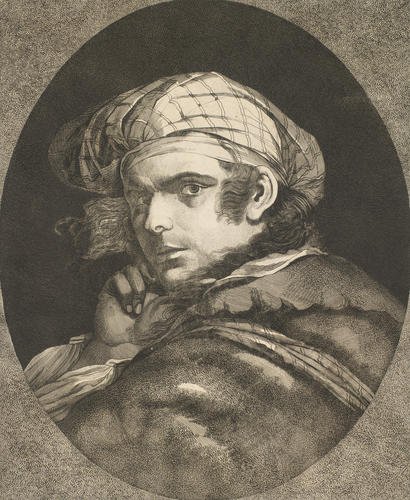After John Hamilton Mortimer (1740-79)
A self-portrait in character c. 1775-80
Etching | 38.9 x 30.4 cm (sheet of paper) | RCIN 659153

After John Hamilton Mortimer (1740-79)
A self-portrait in character c. 1775-80
-
A self-portrait etching of John Hamilton Mortimer; head and shoulders, turned to the left, looking over his shoulder. He wears a striped turban and a heavy mantle. His right hand is raised to his face. Set within an oval. The sheet has been trimmed within the platemark.
This etching corresponds, in reverse, with a drawing in the Victoria and Albert Museum, itself a version of an oil by Mortimer in the Towner Art Gallery, Eastbourne (Victoria and Albert Museum, E.328–1961; for the painting see Sunderland 1986, no. 107). Another etching after the same drawing, by Mortimer’s collaborator Robert Blyth and published in 1782, has been claimed to be a later state of the present print, but is from a different plate: as well as many differences of detail, the tonalities capture none of the dramatic atmosphere and stark lighting. Mortimer did not make many prints, but in 1775–6 he produced a set of 12 heads of figures from Shakespeare that have very much the same character and technique seen here. It seems therefore that the present plate was etched by Mortimer himself and that Blyth made his own version for publication a few years later.
Beside portraits executed to earn a living, Mortimer’s work consisted mainly of paintings of historical subjects (usually British rather than Classical) and wild landscapes with banditti, strongly in the manner of the Italian Baroque painter and printmaker Salvator Rosa and by 1772 Mortimer was being hailed as ‘the English Salvator’. Mortimer undoubtedly saw his own life in similarly romantic terms – a life marked by ‘shipwrecks narrowly avoided, a tussle in which a swordstroke nearly cost him a hand, and various feats of strenuous athleticism interspersed with equally strenuous bouts of drunkenness’ (Walch 1996) – and in the present self-portrait he characterises himself with a glowering brow and long windswept hair partly held by a turban of striped cloth, a common signifier of a figure on the margins of society.
John Hamilton Mortimer was born into a prosperous family in Eastbourne and by the age of 17 had moved to London to pursue a career as an artist. He was impatient for success, preferring the life of an independent liberal artist to that of an honest craftsman: an apprenticeship to the portraitist Thomas Hudson was not completed and from 1759 onwards he exhibited (and gained many prizes) at the St Martin’s Lane Academy, the Duke of Richmond’s Gallery, the Society of Artists and, finally, the Royal Academy of Arts.
Text adapted from Portrait of the Artist, London, 2016 -
Creator(s)
-
Medium and techniques
Etching
Measurements
38.9 x 30.4 cm (sheet of paper)
Category
Object type(s)
Subject(s)
Other number(s)
Alternative title(s)
John Hamilton Mortimer








